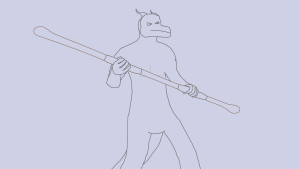Участник:Geeves/Sandbox
Overview
An ancient game of unknown origin. Incredibly popular among almost all Unathi. Armoured participants fight with specially crafted quarterstaves in an attempt to knock the opponent out. It became a notable sport around 300 CE.
History
While Vizravik has existed among all clans for as long as they can remember, no one knows for sure when the initial practice began, owing to the simplicity of the game’s core fundamentals. Historians estimate that many clans began recognizing the sport as early as 200 BCE, but records reveal that the first documented tournament between clans occurred in 325 BCE.
Participants often did not wear any more armour than the clothes they laboured in, which often led to injuries if the warriors did not particularly like each other. This was not very bothersome, as the honour of getting injured during such an event would be enough to garner them eternal fame among their clan.
As time progressed, the lords realized just how many of their subjects were getting injured, and decreed that all Vizravik participants would have to wear armour. This was met by resistance from the general public: The fighters saw wearing armour as a sign of weakness and a lack of masculinity. That is until one of Moghes’ finest tailors created, in 450 BCE, the design of the leather armour the warriors wear til this day.
The Equipment
In the past, people simply used sticks to fight, as a manner of sparring and passing time. This grew to people finding large sticks and carving them into better shapes for fighting. As time went on and designs improved, common unwritten rules were put into place to prevent fighters from being injured too harshly.
Primarily, they included the following:
- “The weapon shall be of average diameter, fitting comfortably in a warrior’s hand, but not being large and hefty enough to cause severe bodily harm.”
- “No spiked implements, the weapon should deal damage only from the power of the warrior’s strike, not penetrating scale.”

This led to a simple quarterstaff being the design of choice for many, with wrappings and grooves where the hands would grasp the weapon. Additionally, warriors would wear thick leather armour to protect their shoulders and wrists. Tailors for each clan created various helmet designs to accommodate warriors with frills of all kinds.
The Fight
Usually combat takes place between two opponents, but there are tournaments where teams of two face off against each other.
Vizravik focuses on body control and knowing when to strike. One should attempt to block or dodge attacks and then deliver a decisive blow when the time is right. This means that this sport isn’t only meant for large brutes with incredible power, though that does help in some cases.
The loser is the first one to surrender or to make no effort to stand up after three seconds of being knocked down. While it is illegal to strike at the head while your opponent is down, actions such as knocking their weapon away from them with your own are considered fair game.
Fighting Styles
There exist many fighting styles, each tailored to a specific type of fighter. Some prefer brute force with few, hard hitting strikes. Some prefer speed, with many light hits. Others prefer precision, hitting where it hurts most.
There is no standard fighting technique, and as such, many people are attracted to the support. It invites newcomers with open arms, hoping that someone brings in a new idea that gives them the edge.
This does not ring true within the Queendom of Szek’Hakh, however. Every single fighter from this matriarchal settlement follows one style, one they dubbed: “Mother’s Fury”. They show unprecedented amounts of aggression, being on a constant attack. This gives them a minor advantage against their male opponents, who cannot always keep up with the flurry of blows.